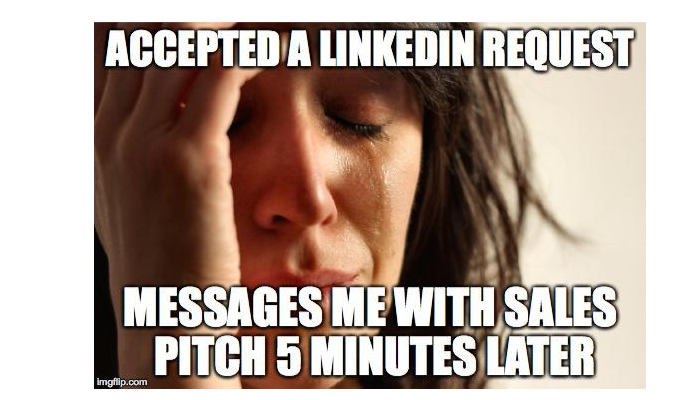Social Selling vs Social Spamming. They represent polar opposites. One is a best practice and the other a worst practice for developing business using social media.
Social Selling is the use of social media to interact directly with their prospects. The interaction is through thoughtful content and timely answers to a prospect until he or she is ready to buy. Social Spamming is unwanted spam appearing on your social networks or email.
The former requires business acumen, people and social skills. The latter uses none of these. Many people think they are Social Selling when they’re Social Spamming.
So you know when it’s Social Selling vs Social Spamming, here are 10 best and worst practices.
- AUTHENTIC VS AUTOMATED MESSAGE: One begins a relevant conversation. The other is a bad sales pitch. When it is apparent in the first couple of sentences of a post or email someone has taken the time to get to know something about you or done some research, you are likely to read a little further to see what comes next. That’s Social Selling. It’s spam when you’re in receipt of a bulk message, even though your name may appear at the beginning,
- OFFER VS PITCH: The first rule of Social Selling is to offer something a prospect is going to value rather than launch into a sales pitch. It could be a download of relevant information, trends or forecasts for your industry. Or an invitation to an event you would go to. It may require your email address and a follow up call occurs. But someone has given you something of value and you took the first action. It’s spamming when nothing is offered; rather someone asks something of you that is purely for their benefit.
- ABUSE OF INMAIL: How many of you have received an invitation to connect with someone on LinkedIn or someone has followed you on Twitter? And you think, what the heck, I’ll connect or follow back. Then, within minutes, you are sent an Inmail or Direct Messaged. And it’s something they are selling or want with an inflated description of themselves or their product. Unfortunately, it is occurring more and more, especially on LinkedIn.
- LINKS IN COMMENTS: Links in a comment are a bad and potentially malicious spamming practice. At best, someone is taking advantage of content someone else has created to insert a self-promotional message about themselves. Or worse, they may be spreading malware that contains a virus or scrapes personal information. Don’t click. Delete.
- BRAGGING VS ENGAGING: When a message begins with a boast about a product, company or themselves, run for the hills. An expression of thoughtfulness is much different. If the message is sincere and the offer has value, it’s Social Selling vs Social Spamming.
- STARTING A 2nd COMMUNICATION WITH “DID YOU GET MY 1st COMMUNICATION”? A drip campaign is a method used in direct marketing to acquire customers through lead nurture programs. It involves sending marketing information to prospects repeatedly over longer periods of time in order to nurture prospects or leads through the marketing funnel. A 2nd message that asks if you got the 1st message isn’t even a drip, it’s spam.
- ASKING IF YOU HAVE “JUST 10 MINUTES”: Some Social Spammers think just cutting straight to the call will bring results. How many of you have gotten an email where the subject line ask for “Just 10 minutes” or “Time for a call today?” My hope is the kind of people who reply “yes” and have this conversation are as obnoxious as the senders.
- UNSUBSCRIBE VS NO ABILITY TO UNSUBSCRIBE: Even if someone has opted in or purchased in the past, you must have a way to unsubscribe when sending commercial email. Many email marketing platforms require and enforce an unsubscribe link for all messages. That’s Social Selling. But it’s spam if the message is emailed from a personal email account like Google Apps, Outlook or from their company’s mail server and you don’t give people the ability to unsubscribe. It’s also a violation of the CAN-SPAM Act, established by the Federal Trade Commission.
- ENDING WITH CALENDAR LINK Some Social Spammers are brash enough, after their obnoxious sale pitch, to put a link to their calendar to schedule a call at the end of their message. Maybe they think it only takes one to make this tactic worthwhile. But I wonder if they get none.
- TELLING SOMEONE YOU WON’T BOTHER THEM AGAIN: The type of Social Spammer who keep sending messages that don’t receive a response, eventually are reduced to try and evoke an action by saying something like “if you are not interested, let me know and I won’t bother you again.” I, of course, don’t respond. I just think “good riddance.”
Do these examples help you see the difference between Social Selling vs Social Spamming? And they best and worst practices to you? Do you have any more to add?

